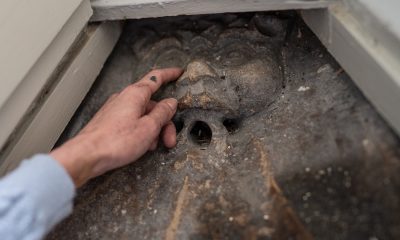New research reveals age of the dinosaurs was triggered by ice
A series of sudden global chills killed off competitors, enabling the legendary reptiles to take over.
Published
2 years ago onBy
Talker News
By Mark Waghorn via SWNS
The age of the dinosaurs was triggered by ice, according to new research.
A series of sudden global chills killed off competitors... enabling the legendary reptiles to take over.
It sheds fresh light on the rise and fall of the biggest land animals that ever roamed Earth.
The Triassic-Jurassic extinction 202 million years ago wiped out 80 percent of all species.
It cleared the way for T Rex, Triceratops, Diplodocus, Velociraptor, Spinosaurus and other iconic beasts to eventually take over.
Their early ancestors were a minor group largely relegated to the polar regions - where they regularly endured freezing conditions.
The telltale evidence is footprints along with odd rock fragments that only could have been deposited by ice.
As sub-zero temperatures spread to lower latitudes, coldblooded reptiles couldn't survive.
Dinosaurs, already adapted, survived the evolutionary bottleneck and spread out. The rest is ancient history.
Dino expert Professor Stephen Brusatte, of the University of Edinburgh, said: "There is a stereotype that dinosaurs always lived in lush tropical jungles.

"But this new research shows that the higher latitudes would have been freezing and even covered in ice during parts of the year.
"Dinosaurs living at high latitudes just so happened to already have winter coats - while many of their Triassic competitors died out."
Ironically, the giant space rock that did for the dinosaurs 136 million years later also sparked a global winter - choking the atmosphere with debris.
During the Triassic, and the following Jurassic, the world was generally hot and steamy. But this did not suit the first dinosaurs.
Lead author Prof Paul Olsen, of Columbia University, New York, said: "Dinosaurs were there during the Triassic under the radar all the time.
"The key to their eventual dominance was very simple. They were fundamentally cold-adapted animals. When it got cold everywhere, they were ready, and other animals weren't."
The finding in Science Advances is based on recent excavations in the remote desert of northwest China's Junggar Basin.
Dinosaurs emerged in temperate southerly latitudes about 231 million years ago. Most of the planet's land mass was one giant continent called Pangaea.
They made it to the far north about 214 million years ago. Expansive tropical and subtropical regions in between were dominated by reptiles.
They included relatives of crocodiles and other fearsome creatures like Lystrosaurus - a terrifying tusked relative of mammals.

Atmospheric concentrations of carbon dioxide ranged above 2,000 parts per million - five times today's levels. Temperatures would have been intense.
There is no evidence of polar ice caps. Deciduous forests grew. But they also got chilly. They would have received little sunlight.
At the end of the Triassic, a geologically brief period of perhaps a million years, more than three quarters of all terrestrial and marine species on the planet disappeared.
They included shelled creatures, corals and all sizable reptiles. Some animals living in burrows, such as turtles, made it through, as did a few early mammals.
The environmental catastrophe was caused by massive volcanic eruptions lasting hundreds of years at a stretch.
Pangaea began splitting apart, opening what is now the Atlantic Ocean, and separating what are now the Americas from Europe, Africa and Asia.
Atmospheric carbon dioxide rocketed even higher, causing deadly temperature spikes on land, and acidifying the oceans.
Belched sulphur aerosols deflected sunlight, causing repeated global volcanic winters lasting more than a decade. Even the tropics froze over.
Uninsulated reptiles perished - but cold adapted, insulated dinosaurs were able to hang on.
The international team analysed fine-grained sandstone and siltstone formations left by sediments in shallow ancient lake bottoms.
They formed 206 million years ago during the late Triassic, through the mass extinction and beyond.
At that time, before landmasses rearranged themselves, the basin lay at about 71 degrees north, well above the Arctic Circle.
Footprints found by the researchers show dinosaurs were present along shorelines. In the lakes, there were abundant pebbles almost an inch wide.
They are known as ice rafetd debris (IRD). It is created when ice forms against a coastal landmass and incorporates bits of underlying rock.

At some point the ice becomes unmoored and drifts away into the adjoining water body. When it melts, the rocks drop to the bottom, mixing with normal fine sediments.
Geologists have extensively studied the phenomenon in the oceans, where it is delivered by glacial icebergs, but rarely in lake beds.
The Junggar Basin discovery adds to the scant record. Te pebbles were likely picked up during winter, when lake waters froze along pebbly shorelines.
When warm weather returned, chunks of that ice floated off with samples of the pebbles in tow, and later dropped them.
Co-author Dr. Dennis Kent, also from Columbia, said: "This shows these areas froze regularly, and the dinosaurs did just fine."
Non-avian dinosaurs including tyrannosaurs had primitive feathers. If not for flight, some coverings could have used for mating display purposes.
But their main purpose was insulation. There is also good evidence that, unlike the cold-blooded reptiles, many dinosaurs possessed warm-blooded, high-metabolism systems. Both qualities would have helped dinosaurs in chilly conditions.
Dr. Kent said: "Severe wintery episodes during volcanic eruptions may have brought freezing temperatures to the tropics, which is where many of the extinctions of big, naked, unfeathered vertebrates seem to have occurred.
"Whereas our fine feathered friends acclimated to colder temperatures in higher latitudes did OK."
The findings defy the conventional imagery of dinosaurs, but some prominent specialists say they are convinced.
Randall Irmis, curator of palaeontology at the Natural History Museum of Utah and specialist in early dinosaurs, said: "This is the first detailed evidence from the high paleolatitudes, the first evidence for the last 10 million years of the Triassic Period, and the first evidence of truly icy conditions.
"People are used to thinking of this as being a time when the entire globe was hot and humid, but that just wasn't the case."
The next step is to understand better this period is for more researchers to look for fossils in former polar areas like the Junggar Basin.
Prof Olsen said: "The fossil record is very bad, and no one is prospecting. These rocks are gray and black, and it is much harder to prospect for fossils in these strata.
"Most palaeontologists are attracted to the late Jurassic, where it is known there are many big skeletons to be had. The paleo-Arctic is basically ignored."
Stories and infographics by ‘Talker Research’ are available to download & ready to use. Stories and videos by ‘Talker News’ are managed by SWNS. To license content for editorial or commercial use and to see the full scope of SWNS content, please email [email protected] or submit an inquiry via our contact form.
You may like
Other Stories


Touching moment brother and sister reunite after 45 years
"I didn't realize it had been so long."


Meet the 2-year-old chef obsessed with cooking shows
She started cooking when she was 11 months old alongside her mom.


Man running marathon after learning how to walk again
He was in a coma for three weeks after he suffered a fall in October 2020.


Couple find medieval gargoyle imp hiding in their bathroom
The couple took to social media for answers.


Farmer finds ‘unprecedented’ litter of 10 fox cubs
The farmer accidentally dug up their den while working.
Top Talkers

 Food & Drink1 week ago
Food & Drink1 week agoWe eat enough grilled cheeses a year to fill 900 Olympic swimming pools

 Broadcast1 week ago
Broadcast1 week agoOver 50% of Americans trust Google more than their schooling

 Parenting18 hours ago
Parenting18 hours agoSingle mom details struggles of feeding her 12 kids

 Broadcast1 week ago
Broadcast1 week agoAmericans eat enough grilled cheeses a year to fill 900 Olympic swimming pools

 Broadcast3 days ago
Broadcast3 days agoOver 40% of Americans have no clue what a 401k is

 Broadcast1 week ago
Broadcast1 week agoGrocery shopping hungry is costing Americans this much

 Funny1 week ago
Funny1 week agoCops confused by crow mimicking police siren

 Broadcast2 days ago
Broadcast2 days agoHow hard is it for Americans to live sustainably?
